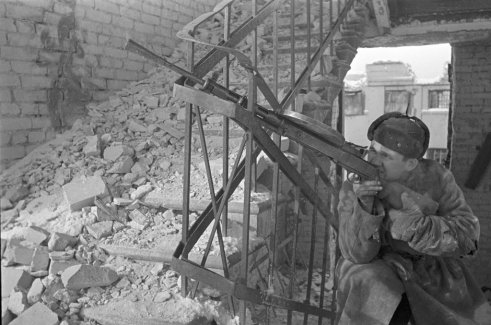
“The people of our country, who treat the Red Army with love and respect, are now starting to be disappointed with it, lose faith in the Red Army, and many of them curse the Army for its fleeing to the east…The conclusion is that it is time to stop the retreat. Not a single step back!” (Order No. 227). These were the words from Stalin’s Order 227, which demanded an iron will from the Red Army to hold and drive back the invading German forces. This fiery order came after a series of failures to successfully repel the German assault.
The Volga was set as the final line, the Red Army could retreat no further. For the Germans, Stalingrad served as the gateway to the oil rich city of Baku, which supplied the Soviet military and civilians with precious fuel (Freeze 380). On top of that, the city held symbolic value, a victory in Stalingrad would mean a crippled Soviet morale and war effort (The Nazi Tide Stops). Within two weeks, the German Sixth Army would capture most of the city (Freeze 381). With Stalin’s order still in their minds, the soldiers of the Red Army continued to wrestle for control of the city. Fighting devolved into bloody street fighting and house by house combat (The Nazi Tide Stops).

A Soviet counter offensive started in November of 1942, Operation Uranus led by Gregorii Zhukov pushed across the German line and encircled the remaining Sixth Army (Freeze 381). The encircled Germans were now under siege with Hitler refusing to order a break out (Freeze 381). Soviet anti-aircraft weapons foiled attempts by the Luftwaffe to resupply the besieged Germans, many of whom starved or froze to death during the fighting (The Nazi Tide Stops).
On February 2, 1943, the German Sixth Army surrendered with 110,000 of the original 400,000 being taken as prisoners of war (The Nazi Tide Stops). The Soviets, on the other hand, suffered around 750,000 dead, wounded, or missing in action (The Nazi Tide Stops). This victory would shift the tide of the war for the Soviets, emboldening them to push the Germans further back and to relieve the siege on Leningrad (Freeze 381). Not until Kursk would the Germans take another major offensive, even still the scales had tipped in favor of the Soviets with the victory at Stalingrad (Freeze 381).
Sources:
Siegelbaum, Lewis. The Nazi Tide Stops. Seventeen Moments in Soviet History. http://soviethistory.msu.edu/1943-2/the-nazi-tide-stops/
Stalin, Iosif. Order Number 227. Robert H. McNeal, ed. Resolutions and Decisions of the Communist Party of the Soviet Union (Toronto: University of Toronto Press, 1974). Accessed: http://soviethistory.msu.edu/1943-2/the-nazi-tide-stops/no-one-steps-back/
Freeze, Gregory. Russia a History. 3rd edition. Oxford University Press. 2009.
Image Sources:
Zelma Photographs Stalingrad. Seventeen Moments in Soviet History. http://soviethistory.msu.edu/1943-2/the-nazi-tide-stops/the-nazi-tide-stops-visual-essays/#
Stalingrad was also symbolic because of its name – the Red Army could not lose Stalin’s city. This was one of the bloodiest battles in history and I think you did a good job of examining it. Maybe you could’ve gone a little more in depth on the street fighting? But great job overall!
LikeLike
I loved all the facts about the war and fighting! Stalingrad was a major victory for the Red Army and a surprising one at that. You did a great job!
LikeLike
I thought that the point you made about the Soviet anti-aircraft was really interesting. I was not aware that they ruined plans to get supplies to Germans that needed them. I think this post was really interesting and I really liked the title!
LikeLike
I like that you included all the death figures on both sides at the end, it really shows how much of a human cost came with the victory at Stalingrad. I thought it was interesting that the Red Army was blamed for the advance of the Germans, especially since Stalin initially told the army to stand down when the invasion began.
LikeLike
The Battle of Stalingrad was some of the bloodiest fighting in the history of humanity. The casualty figures you included are mind-blowing in scale. When compared to other allied and axis casualties, no other battle even comes close. The Soviets were fighting in their homeland in a last ditch effort to stop the German advance, and the Germans, once trapped were fighting for their very survival. All in all this was a great post and I think you did a great job outlining the importance and scale of the battle.
LikeLike